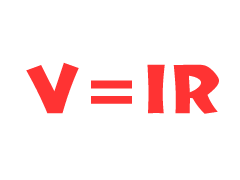Resistors
| This article is part of the PhysicsHelp Tutoring Wiki |

The resistor is going to be your least despised electrical element during first year physics. It is the most sraight forward component and can often be used to jog your memory with regards to other components. The two symbols above are schematic representations of resistors, "R2" is used in north america and "R1" is used in europe.

This is what an actual resistor looks like. There are other types of resistors but this type is the most common. It is composed of two wires that are connected by a blob of something. That something is a carbon ceramic mixture. The proportions of carbon and ceramic in the blob of stuff will determine the value of resistance. So what is resistance anyways? Well, resistance is the measure of how much more difficult it is for electricity to flow through a component.
Imagine if you connected a circuit connected on one side to a battery and the other side to rubber glove. The battery supplies a voltage but because the glove is made of rubber almost no electricity flows through it. Therefore, it can be concluded that the glove has a very high resistance.

What this equation conveys is that if we put some voltage across something (the rubber glove) and measured the current passing through it then the resistance is the constant that the current would need to be multiplied to in order to equal the voltage.
Now imagine if you applied that same battery to a copper wire instead of the rubber glove. The current would nearly flow freely from one termminal to the other so the resistance would be very low. An interesting note is that resistance depends on the size or quantity of the component so a big rubber glove will have more resistance than a small rubber glove.

R = resistance p = resistivity L = length of component A = area of the component
Introduced to you in this equation is the property of a material called resistivity. The resistivity determines what the resistance of an object will be if we know what the length and the cross sectional area of the component are ( assuming that the cross section remains constant over the entire length of the component).
To get an idea for all this, the value of resistivity of rubber is around 10^13 ohm*meters and for copper it is around 10^-8 ohm*meters. Imagine if we had a cylindrical piece of rubber and a cylindrical piece of copper, both 1m long and both with a circular cross sectional area of 1m^2 (r = 0.56m, d = 1.12m). These are big cyclinders I know but what I'm trying to illustrate is the difference in resistance between copper and rubber. You will see that L and A are both 1 so the resistance is equal to the resistivity. That means that the copper cyclinder has 10^-8 ohms of resistance and the rubber cylinders has 10^13 ohms! Rubber has 10^21 times more ohms!
- Back to Physics102